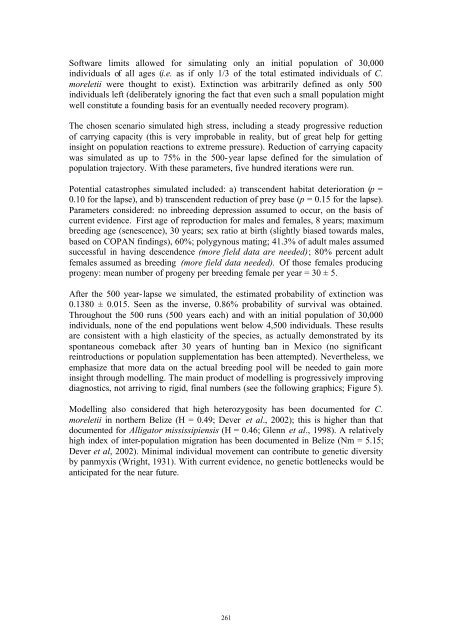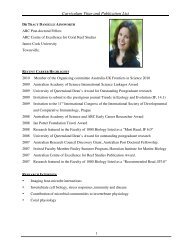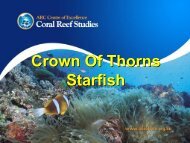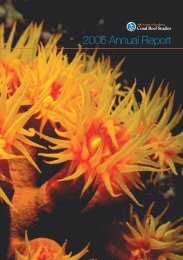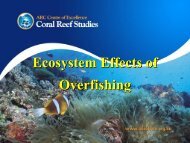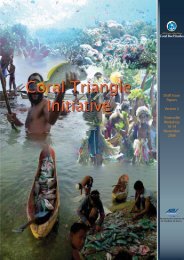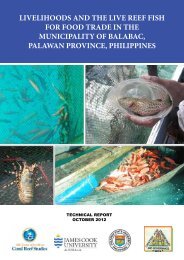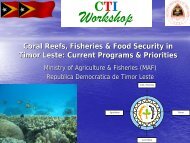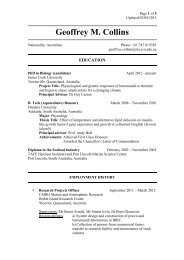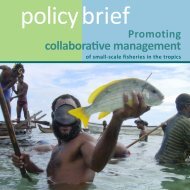Proceedings of the 18th Working Meeting of the Crocodile Specialist ...
Proceedings of the 18th Working Meeting of the Crocodile Specialist ...
Proceedings of the 18th Working Meeting of the Crocodile Specialist ...
You also want an ePaper? Increase the reach of your titles
YUMPU automatically turns print PDFs into web optimized ePapers that Google loves.
S<strong>of</strong>tware limits allowed for simulating only an initial population <strong>of</strong> 30,000<br />
individuals <strong>of</strong> all ages (i.e. as if only 1/3 <strong>of</strong> <strong>the</strong> total estimated individuals <strong>of</strong> C.<br />
moreletii were thought to exist). Extinction was arbitrarily defined as only 500<br />
individuals left (deliberately ignoring <strong>the</strong> fact that even such a small population might<br />
well constitute a founding basis for an eventually needed recovery program).<br />
The chosen scenario simulated high stress, including a steady progressive reduction<br />
<strong>of</strong> carrying capacity (this is very improbable in reality, but <strong>of</strong> great help for getting<br />
insight on population reactions to extreme pressure). Reduction <strong>of</strong> carrying capacity<br />
was simulated as up to 75% in <strong>the</strong> 500-year lapse defined for <strong>the</strong> simulation <strong>of</strong><br />
population trajectory. With <strong>the</strong>se parameters, five hundred iterations were run.<br />
Potential catastrophes simulated included: a) transcendent habitat deterioration (p =<br />
0.10 for <strong>the</strong> lapse), and b) transcendent reduction <strong>of</strong> prey base (p = 0.15 for <strong>the</strong> lapse).<br />
Parameters considered: no inbreeding depression assumed to occur, on <strong>the</strong> basis <strong>of</strong><br />
current evidence. First age <strong>of</strong> reproduction for males and females, 8 years; maximum<br />
breeding age (senescence), 30 years; sex ratio at birth (slightly biased towards males,<br />
based on COPAN findings), 60%; polygynous mating; 41.3% <strong>of</strong> adult males assumed<br />
successful in having descendence (more field data are needed); 80% percent adult<br />
females assumed as breeding (more field data needed). Of those females producing<br />
progeny: mean number <strong>of</strong> progeny per breeding female per year = 30 ± 5.<br />
After <strong>the</strong> 500 year-lapse we simulated, <strong>the</strong> estimated probability <strong>of</strong> extinction was<br />
0.1380 ± 0.015. Seen as <strong>the</strong> inverse, 0.86% probability <strong>of</strong> survival was obtained.<br />
Throughout <strong>the</strong> 500 runs (500 years each) and with an initial population <strong>of</strong> 30,000<br />
individuals, none <strong>of</strong> <strong>the</strong> end populations went below 4,500 individuals. These results<br />
are consistent with a high elasticity <strong>of</strong> <strong>the</strong> species, as actually demonstrated by its<br />
spontaneous comeback after 30 years <strong>of</strong> hunting ban in Mexico (no significant<br />
reintroductions or population supplementation has been attempted). Never<strong>the</strong>less, we<br />
emphasize that more data on <strong>the</strong> actual breeding pool will be needed to gain more<br />
insight through modelling. The main product <strong>of</strong> modelling is progressively improving<br />
diagnostics, not arriving to rigid, final numbers (see <strong>the</strong> following graphics; Figure 5).<br />
Modelling also considered that high heterozygosity has been documented for C.<br />
moreletii in nor<strong>the</strong>rn Belize (H = 0.49; Dever et al., 2002); this is higher than that<br />
documented for Alligator mississipiensis (H = 0.46; Glenn et al., 1998). A relatively<br />
high index <strong>of</strong> inter-population migration has been documented in Belize (Nm = 5.15;<br />
Dever et al, 2002). Minimal individual movement can contribute to genetic diversity<br />
by panmyxis (Wright, 1931). With current evidence, no genetic bottlenecks would be<br />
anticipated for <strong>the</strong> near future.<br />
261


